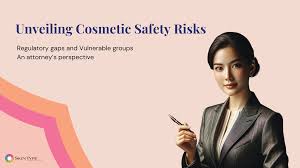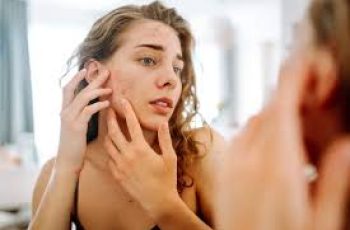
Unveiling Cosmetic Safety Risks: Regulatory Gaps and Vulnerable Groups
In the vibrant and often glamorous world of cosmetics, the allure of beauty products masks an underlying and potentially serious issue: the safety of these products is not as strictly regulated as many consumers might assume.
Cosmetic companies are allowed to use a vast array of ingredients in their formulations, but the United States Food and Drug Administration (FDA) has only limited authority to oversee, regulate, or intervene when these products pose risks to consumer health.
This regulatory gap exposes consumers to potential harms, especially those belonging to vulnerable groups such as pregnant women, children, economically disadvantaged individuals,
people living in environmentally at-risk locations, those with limited English proficiency, and various racial and ethnic communities who face disproportionate exposure to harmful chemicals.
In this article, we explore the inherent dangers of an under-regulated cosmetics market and examine how new legislation, particularly the Modernization of Cosmetics Regulation Act (MoCRA),
promises to reshape this landscape, improve safety, and protect these at-risk populations.
The Hidden Risks in Cosmetics: Why Regulation Matters
Cosmetics are products applied to the skin, hair, or nails to enhance appearance, but their ingredients can sometimes pose health risks.
The current U.S. regulatory framework relies heavily on companies to self-regulate, with the FDA playing a reactive role rather than a proactive one.
For decades, the FDA has lacked the authority to require pre-market safety testing, mandate ingredient disclosures beyond basic labeling, or enforce mandatory recalls when harmful products enter the market.
This regulatory shortfall is concerning because many cosmetic ingredients have been linked to neurotoxicity, hormonal disruption, reproductive harm, and carcinogenic effects.
Without stringent oversight, harmful substances can persist in everyday products—from shampoos and makeup to lotions and sunscreens—posing dangers that accumulate over time.
Vulnerable Populations: Who Bears the Greatest Risk?
While everyone using cosmetics is potentially at risk, some groups face heightened vulnerabilities due to physiological sensitivity, social and economic factors, or environmental exposures.
These groups include:
1. Pregnant Women: Protecting Maternal and Fetal Health
Pregnancy represents a period of increased biological sensitivity, where exposure to toxic chemicals can have lasting effects on both the mother and the developing fetus.
The American College of Obstetricians and Gynecologists (ACOG) warns that certain chemicals found in personal care products may disrupt reproductive health or cause developmental issues.
Specific ingredients to avoid include:
Aluminum: A known neurotoxin with potential developmental toxicity.
Beta Hydroxy Acids (BHAs): Including salicylic acid, which has been associated with embryo malformations.
Diethanolamine (DEA): Common in hair and body products, linked to sperm abnormalities.
These risks underscore the importance of careful ingredient scrutiny and cautious product selection during pregnancy, as even low-level exposures can have significant effects.
2. Children: Guardians of Innocence and Health
Children’s smaller body size, developing organs, and immature immune systems make them particularly vulnerable to the toxic effects of chemicals found in cosmetics.
Studies have linked exposure to harmful ingredients in children’s makeup and body products to neurodevelopmental disorders and poisoning risks from accidental ingestion.
A stark example occurred in 2019 when Claire’s, a popular retailer targeting young girls, voluntarily recalled a makeup set after the FDA detected asbestos—a carcinogen—in the products.
This alarming incident highlights the urgent need for stricter regulations and vigilant consumer awareness to protect children from such dangers.
3. Racial Disparities: Chemical Exposure and Health Inequities
Cosmetic formulations vary based on targeted demographics, often leading to significant disparities in chemical exposure across racial groups.
For instance, hair products designed for Black women frequently contain a range of hazardous chemicals, including endocrine disruptors that interfere with hormonal balance.
Comprehensive studies involving over 38,000 U.S. women reveal troubling patterns:
Non-Hispanic Black, Mexican American, Other Hispanic, and Multi-Racial women face disproportionately high exposure to harmful substances such as pesticides, parabens, and heavy metals.
Alarmingly, a focused study on women of color found that about 65% of their product labels included warnings about cancer risks, reproductive harm, or endocrine disruption.
These disparities point to systemic inequities in cosmetic safety and call for targeted regulatory actions to protect these populations.
4. Economically At-Risk Individuals: Affordability vs. Safety
Economic vulnerability directly affects access to safer cosmetic products.
Individuals with limited financial means often resort to cheaper alternatives, which may contain lower-quality ingredients or higher levels of potentially toxic substances.
This economic constraint places disadvantaged consumers at greater risk of chemical exposure and adverse health outcomes.
Addressing this intersection requires industry and regulatory initiatives focused on making safer products affordable and accessible.
Public awareness campaigns, subsidies, and improved labeling can empower economically at-risk groups to make safer choices within their budget constraints.
5. Geographic Risk Factors: The Environment Matters
Where a person lives can significantly influence their risk related to cosmetic chemical exposure.
Residents of highly polluted urban areas, communities near industrial facilities, or places with contaminated water supplies face cumulative exposure from multiple environmental sources.
When combined with chemicals from cosmetics, these environmental pollutants can have a synergistic effect, increasing the overall toxic burden on the body.
Regulatory approaches must therefore account for geographic disparities and include community-based interventions that address environmental justice alongside product safety.
6. Limited English Proficiency: The Language Barrier in Safety
Consumers with limited English proficiency face challenges understanding product labels, ingredient lists, and safety warnings.
This communication gap can lead to inadvertent use of harmful products, as complex chemical names and instructions are often not available in accessible languages.
To protect these consumers, cosmetic companies and regulators should implement multilingual labeling and educational outreach.
Providing clear, culturally sensitive information empowers all consumers to make informed, safer choices.
The Promise of MoCRA: Transforming Cosmetic Safety
The Modernization of Cosmetics Regulation Act (MoCRA) represents a landmark legislative effort to address long-standing regulatory gaps in cosmetic safety.
MoCRA enhances the FDA’s authority in several critical ways:
Mandatory Registration: Cosmetic facilities must register with the FDA, allowing greater oversight of manufacturing practices.
Ingredient Disclosure: Companies are required to submit detailed ingredient information, enabling the FDA to identify and assess potentially harmful substances.
Mandatory Recalls: The FDA gains the power to order recalls of unsafe products, rather than relying on voluntary company actions.
Label Transparency: Full ingredient lists must be disclosed on product labels, improving consumer awareness and informed choice.
These reforms aim to create a more transparent and accountable cosmetic industry, directly benefiting consumers—especially vulnerable populations who have historically borne disproportionate risks.
Empowering Consumers: Knowledge as Protection
While regulatory improvements like MoCRA are vital, consumer awareness remains a key defense against cosmetic hazards. Vulnerable groups should actively engage in:
Researching Ingredients: Understanding common harmful chemicals and how to identify them.
Consulting Experts: Seeking advice from healthcare providers and dermatologists regarding safe products.
Advocacy: Supporting policies and organizations that promote cosmetic safety and equity.
Using Tools: Participating in skin assessments like the Baumann Skin Type quiz to tailor skincare routines safely and effectively.
Empowered consumers are better equipped to navigate the complex cosmetic marketplace and make choices that safeguard their health.
A Collective Call for Safer Cosmetics
The journey toward safer cosmetics is a shared responsibility.
Regulatory bodies must enforce robust safety standards, manufacturers should prioritize transparency and safety in product development, and consumers must stay informed and vigilant.
Advocacy organizations, public health initiatives, and community leaders play essential roles in bridging knowledge gaps and promoting equity.
Together, these efforts can reshape the cosmetic industry into one that truly protects and respects the health of all individuals, regardless of age, race, economic status, or geography.
Conclusion
The cosmetic industry today stands at a crossroads.
On one side lies a future where products are safer, regulations more stringent, and consumers empowered; on the other, the status quo of regulatory gaps and unchecked chemical exposures that disproportionately affect society’s most vulnerable members.
Legislation like MoCRA signals hope, offering a comprehensive framework to close loopholes and strengthen oversight.
However, the full realization of safer cosmetics depends on collective action—from lawmakers and industry players to consumers and communities.
By shining a light on cosmetic safety risks, recognizing vulnerable groups, and embracing both regulation and education, we can move toward a world where beauty and health coexist harmoniously—where every individual has the right to use personal care products without fear.


